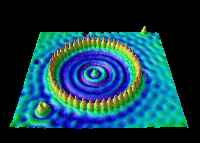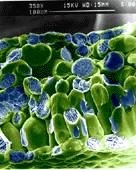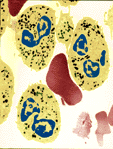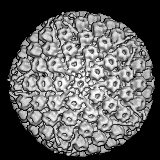Seeing is BelievingLen Fisheron ways of seeingOriginal URL: http://www.uwe.ac.uk/fas/wavelength/wave15/fisher.html |
|
| I saw an atom today.
I saw it the way that a blind person sees. By feeling for it, using the scientist’s equivalent of a white stick - a tiny pointer, waved backwards and forwards across a surface until it encountered an obstacle and rode up over it. An obstacle the size of an atom. Feeling further, I found another atom next to it. And then another. And then a whole string, forming a rope that abruptly split into two. I was witnessing an every-day miracle of life - a DNA molecule dividing into two. The thrill of such moments stays with you. My heart is thumping with remembered excitement as I write. Antonie von Leeuwenhoek must have felt like this over three hundred years ago, when he first looked down a microscope to find an unsuspected world of living bacteria in a water drop. New ways of seeing transform our lives. Microscope and telescope alike have contributed, not just to science, but to all of our self-images. The knowledge that we are made of atoms, and that there is a world of miniature creatures sharing our planet, gives us a perspective on our own existence that we would not otherwise have had. Seeing the distant stars, and recognising that they too are born, live and die, equally affects our view of ourselves. Many of the new ways of seeing, developed by physicists in trying to understand how the world works, have a more immediate impact on our lives. The microscope is used by pathologists to examine our blood for early signs of disease. X-rays turn us into Supermen, able to see through flesh to the bones beneath. Ultrasound, a high frequency version of the sonar used to detect submarines, lets us see through flesh to the flesh beneath, as many proud prospective parents are well aware. In the physicist’s hands, even something as apparently simple as a magnet can be used to make pictures. Microscopic arrays of magnetised particles record our favourite TV programmes, and also line our credit cards to give an array of bars and spaces that can be seen by an appropriate machine. And magnetic resonance imaging uses signals that pass through fat but are absorbed by water, giving a picture as though everything but the water has been taken away. It is a picture that can tell us about abnormalities in the brain or about how evenly a loaf of bread has been baked. Pictures can be indirect, like the tracks of water droplets left in a cloud chamber by the scattered fragments of shattered atoms. Jet trails from a subatomic world, our main evidence for the existence of that world. Some of the fragments discovered have been put to use. Positrons, for example, whose tracks can be used to build up an image of the body using the oddly named PET (positron emission tomography) technique. Pictures can be positive or negative. My favourite isolated Australian beach is populated mainly by kangaroos. Yet I have never actually seen them - only their tracks in the sand, washed away each night by the incoming tide. Some tracks can be more permanent, like those of our ancestor Lucy in African sand, now set into rock. Negative images these, like the dark regions where the light has struck on a photographic negative. Indicators of former presence. By now you may be thinking that this is to be a panegyric for science-based technology. Hooray for the scientists. Ask them for something, and they’ll come up with it. But that’s not the way it happens. It happens because scientists have a vocation - to understand better how the world works. It is a vocation that we have in common with writers, artists, priests, philosophers, and indeed with all thinking people. But scientists concentrate on the physical world. It is only a small part of the bigger picture, but it is the easiest bit, and consequently that which we understand best. Within its limited scope, science has been a very successful enterprise. How does the world work? Science has succeeded by focusing on that question. Röntgen discovered X-rays in the process of trying to understand what matter is made of. Much modern technology is based on the fact that electric currents can make magnets move (and vice versa) - an effect discovered by a man who was trying to demonstrate that his picture of how the world worked meant that there could not be such an effect. The magnetic resonance technique started as a test of a theoretical idea, whose only potential use was to observe closely packed molecules wriggling around. Lasers, the basis of holography and also of CD players, were developed as the experimental realisation of an idea concerning the nature of light. You don’t discover X-rays by setting out to discover X-rays. How can you aim to discover what you don’t know exists? Nor is it likely that X-rays would have been discovered by someone looking for a non-surgical way to see breaks in bones, or bullets in bodies. Some other technique may have been found, but it would have had to be based on a known effect. Science has given us a great number of new ways to see the world. In doing so, it has influenced our perception of ourselves, for better or worse; knowledge brings with it the pain of reassessment. It has also given us a measure of control of our physical world, again for better or worse; with power goes responsibility. But we will only continue to advance if we continue to pursue science in its proper sense, as one way among many of understanding how the world works. That’s what excites us; that’s what produces major discoveries. Leeuwenhoek’s excitement at seeing ‘animalcules’ under the microscope, my excitement at seeing atoms, this is the driving force for scientific discovery. Without that, discoveries will cease to happen. Seeing is Believing was a runner up in 1997 'Science in Print' competition run by the Institute of Physics. Len Fisher is in the Faculty of Applied Sciences at the University of the West of England, Bristol. |
|
|
| |
|
| |
|
| |
|
| |




